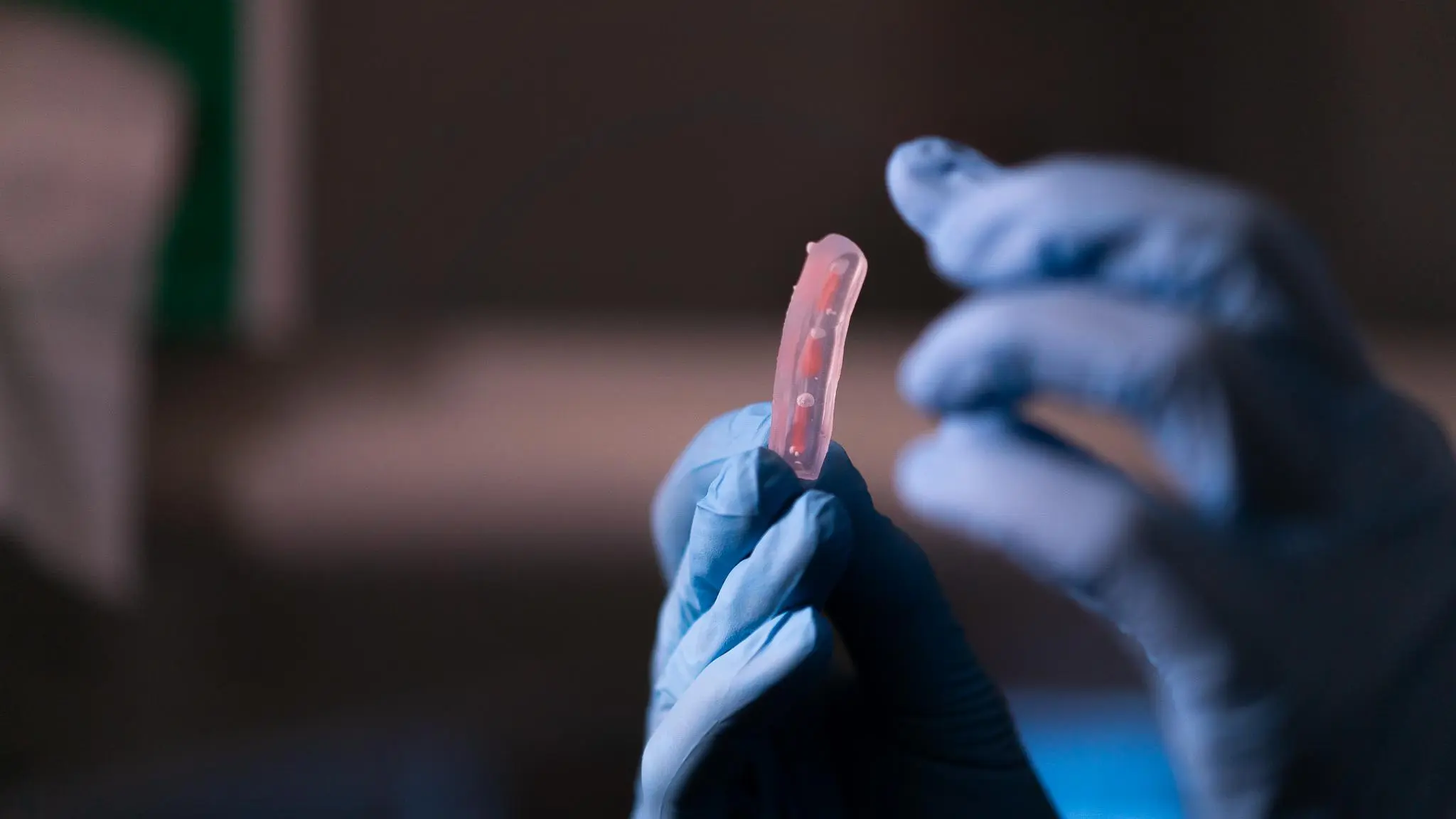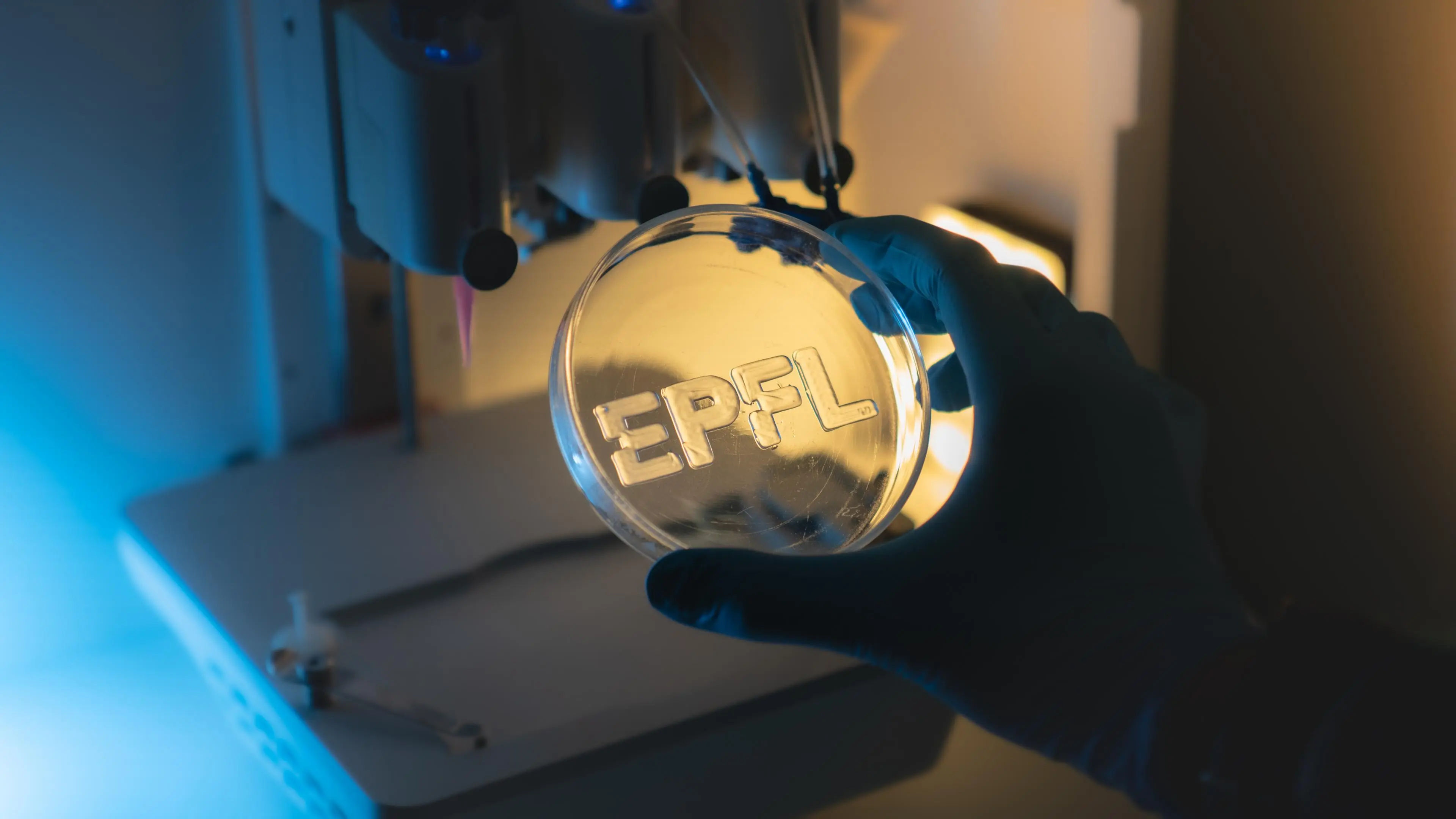For engineers working on soft robotics or wearable devices, keeping things light is a constant challenge: heavier materials require more energy to move around, and – in the case of wearables or prostheses – cause discomfort. Elastomers are synthetic polymers that can be manufactured with a range of mechanical properties, from stiff to stretchy, making them a popular material for such applications. But manufacturing elastomers that can be shaped into complex 3D structures that go from rigid to rubbery has been unfeasible until now.
“Elastomers are usually cast so that their composition cannot be changed in all three dimensions over short-length scales. To overcome this problem, we developed DNGEs: 3D-printable double network granular elastomers that can vary their mechanical properties to an unprecedented degree,” says Esther Amstad, head of the Soft Materials Laboratory in EPFL’s School of Engineering.
Eva Baur, a PhD student in Amstad’s lab, used DNGEs to print a prototype ‘finger’, complete with rigid ‘bones’ surrounded by flexible ‘flesh’. The finger was printed to deform in a pre-defined way, demonstrating the technology’s potential to manufacture devices that are sufficiently supple to bend and stretch, while remaining firm enough to manipulate objects.
 The lab’s DNGE prototype ‘finger’ with rigid ‘bones’ surrounded by flexible ‘flesh’ © Adrian Alberola
The lab’s DNGE prototype ‘finger’ with rigid ‘bones’ surrounded by flexible ‘flesh’ © Adrian Alberola
With these advantages, the researchers believe that DNGEs could facilitate the design of soft actuators, sensors, and wearables free of heavy, bulky mechanical joints. The research has been published in the journal Advanced Materials.
Two elastomeric networks; twice as versatile
The key to the DNGEs’ versatility lies in engineering two elastomeric networks. First, elastomer microparticles are produced from oil-in-water emulsion drops. These microparticles are placed in a precursor solution, where they absorb elastomer compounds and swell up. The swollen microparticles are then used to make a 3D printable ink, which is loaded into a bioprinter to create the desired structure. The precursor is polymerized within the 3D-printed structure, creating a second elastomeric network that rigidifies the entire object.
 Example of DNGEs (3D-printable double network granular elastomers) © Titouan Veuillet
Example of DNGEs (3D-printable double network granular elastomers) © Titouan Veuillet
While the composition of the first network determines the structure’s stiffness, the second determines its fracture toughness, meaning that the two networks can be fine-tuned independently to achieve a combination of stiffness, toughness, and fatigue resistance. The use of elastomers over hydrogels – the material used in state-of-the-art approaches – has the added advantage of creating structures that are water-free, making them more stable over time. To top it off, DNGEs can be printed using commercially available 3D printers.
“The beauty of our approach is that anyone with a standard bioprinter can use it,” Amstad emphasizes.
One exciting potential application of DNGEs is in devices for motion-guided rehabilitation, where the ability to support movement in one direction while restricting it in another could be highly useful. Further development of DNGE technology could result in prosthetics, or even motion guides to assist surgeons. Sensing remote movements, for example in robot-assisted crop harvesting or underwater exploration, is another area of application.
Amstad says that the Soft Materials Lab is already working on the next steps toward developing such applications by integrating active elements – such as responsive materials and electrical connections – into DNGE structures.
References
E. Baur, B. Tiberghien, E. Amstad, 3D Printing of Double Network Granular Elastomers with Locally Varying Mechanical Properties. Adv. Mater. 2024, 2313189. https://doi.org/10.1002/adma.202313189












Responses (0 )